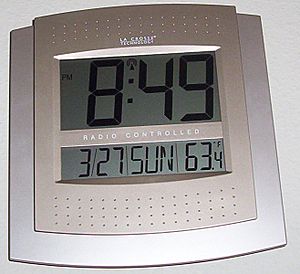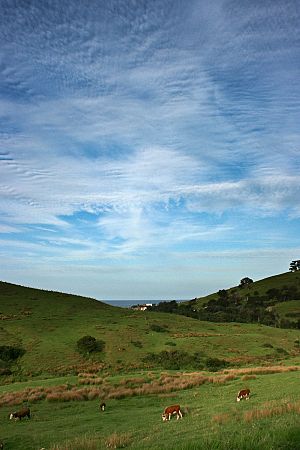Time in New Zealand facts for kids
| Time zone | Standard Time | Daylight Time |
|---|---|---|
| New Zealand | UTC+12:00 | UTC+13:00 |
| Chatham Islands | UTC+12:45 | UTC+13:45 |
New Zealand uses two main time zones. The main islands follow New Zealand Standard Time (NZST). This time is 12 hours ahead of Coordinated Universal Time (UTC). The small Chatham Islands use Chatham Standard Time (CHAST), which is 12 hours and 45 minutes ahead of UTC.
During the summer months, New Zealand uses daylight saving time. Clocks are moved forward by one hour. This period starts on the last Sunday in September and ends on the first Sunday in April. During this time, New Zealand Daylight Time (NZDT) is 13 hours ahead of UTC. Chatham Daylight Time (CHADT) is 13 hours and 45 minutes ahead of UTC.
New Zealand's connected areas, like the Cook Islands, Niue, and Tokelau, use their own different time zones.
Contents
History of New Zealand Time
On 2 November 1868, New Zealand became the first country to officially use a standard time across the whole nation. This happened about 15 years before any other country did. New Zealand's time was based on a line of longitude 172° 30′ East of Greenwich. This meant it was 11 and a half hours ahead of Greenwich Mean Time (GMT). This first standard time was called New Zealand Mean Time (NZMT). The Chatham Islands were 45 minutes ahead of mainland New Zealand.
In 1941, during the Second World War, clocks were moved forward by half an hour. This was done to save electricity. This change made New Zealand 12 hours ahead of GMT. This new time became permanent in 1946. The Standard Time Act 1945 made the 180°E line the basis for New Zealand Time. NZST stayed half an hour ahead of NZMT. The Chatham Islands remained 45 minutes ahead of NZST.
In the late 1940s, the atomic clock was invented. These clocks are extremely accurate. In 1972, a new international time scale called Coordinated Universal Time (UTC) was created. UTC is based on atomic clocks. Sometimes, an extra second, called a leap second, is added or removed to keep UTC in line with Earth's rotation. The Time Act 1974 in New Zealand set New Zealand Standard Time as 12 hours ahead of UTC.
In 2011, Tokelau, a New Zealand dependency, changed its time zone. They moved their clocks forward by 24 hours. They did this by skipping 30 December that year.
Daylight Saving Time (DST) in New Zealand
Daylight saving time (DST) means moving clocks forward during warmer months. This gives more daylight in the evenings. In 1909, a politician named Thomas Sidey tried to make a law for DST. The Summer Time Act 1927 finally made it happen. In 1927, clocks moved forward by one hour from November to March. People did not like this much. So, in 1928, the change was reduced to half an hour. This half-hour shift became permanent from October to March each year. In 1933, the period was made even longer, from September to April.
This continued until the Second World War. In 1941, emergency rules made daylight saving last all year. This was renewed yearly until 1946. Then, the Standard Time Act 1945 made the old NZMT time system permanent. What was called NZ Summer Time (NZST) became the new NZ Standard Time.
The Time Act 1974 allowed the Governor-General to announce when daylight saving time would happen. This was a one-hour shift. It started from the first Sunday in November to the last Sunday in February. The next year, this changed. The New Zealand Time Order 1975 set the period from the last Sunday in October to the first Sunday in March.
In 1985, a big survey was done to see how people felt about NZDT. It looked at how it affected work, fun, and different groups of people. The survey showed that over 76% of people wanted NZDT to continue or be made longer.
The survey also found that men and women felt similar about DST. Support for NZDT was higher in cities. In the small farming town of Ararua in Northland, people famously refused to change their clocks for some years. Only a small number of people wanted to shorten or stop NZDT.
Because of the survey, in 1988, the government tried a longer NZDT period. It ran from October 1989 to March 1990. People were asked to share their thoughts on this longer period.
The Daylight Time Order 1990 then set NZDT to run from the first Sunday in October to the third Sunday in March.
On 30 April 2007, the government made the daylight saving period even longer. It went from 24 to 27 weeks. Since September 2007, daylight saving now starts on the last Sunday in September. It ends on the first Sunday in April.
New Zealand time, including DST, is used by several Antarctic bases. These bases get their supplies from New Zealand. This means that the Amundsen–Scott South Pole Station changes its clocks for DST. This happens even though the sun is always up in summer and always down in winter there. Changing the clocks helps them communicate better with New Zealand offices.
Other countries connected to New Zealand, like the Cook Islands, Niue, and Tokelau, do not use DST. Two of them are on the other side of the International Date Line. This means they are 22 to 24 hours behind New Zealand time.
How New Zealand Time is Kept
New Zealand's standard time is managed by the Measurement Standards Laboratory (MSL). This is part of the New Zealand Government. New Zealand standard time is based on Coordinated Universal Time (UTC). UTC is kept very close to the international atomic time scale. This scale is managed by the International Bureau of Weights and Measures in Paris.
New Zealand time is shared in different ways. These include time signals broadcast on Radio New Zealand. You can also hear it from a speaking clock service. Another way is through the Network Time Protocol for computers.
New Zealand's Connected Islands
| Time zone | Standard Time | Daylight Time |
|---|---|---|
| Tokelau | UTC+13:00 | |
| Cook Islands | UTC−10:00 | |
| Niue | UTC−11:00 | |
| Ross Dependency | UTC+12:00 | UTC+13:00 |
New Zealand has two associated states in the Pacific Ocean. They are on the other side of the International Date Line:
- The Cook Islands are in the UTC−10:00 time zone. They do not use daylight saving time. Clocks in the Cook Islands are 22 or 23 hours behind New Zealand. For example, if it's noon on Thursday in New Zealand, it's 1 PM or 2 PM on Wednesday in the Cook Islands.
- Niue is in the UTC−11:00 time zone. It also does not use daylight saving time. Clocks in Niue are 23 or 24 hours behind New Zealand. So, if it's noon on Thursday in New Zealand, it's noon or 1 PM on Wednesday in Niue.
Tokelau is a New Zealand dependency. It is in the UTC+13:00 time zone and does not use daylight saving time. Clocks in Tokelau are set to the same time as New Zealand, or one hour ahead. If it's noon on Thursday in New Zealand, it's noon or 1 PM on Thursday in Tokelau.
The Ross Dependency, McMurdo Station, and Amundsen–Scott South Pole Station in Antarctica all use New Zealand Standard Time (NZST) and New Zealand Daylight Time (NZDT).



